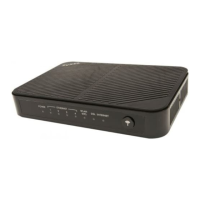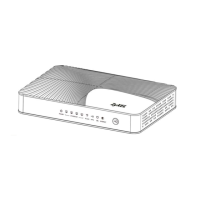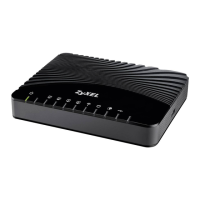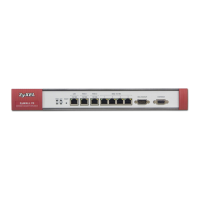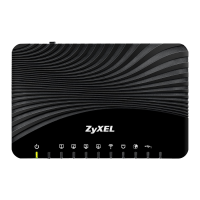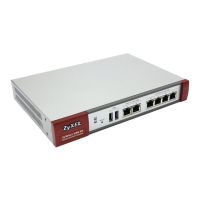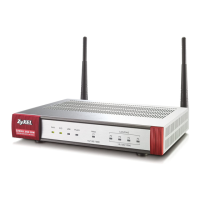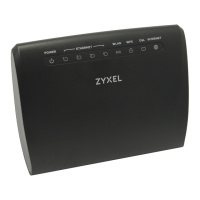
Do you have a question about the ZyXEL Communications AMG1302-T11C and is the answer not in the manual?
| Frequency band | 2.4 GHz |
|---|---|
| Dynamic DNS (DDNS) | Yes |
| Networking standards | IEEE 802.11b, IEEE 802.11g, IEEE 802.11n, IEEE 802.1Q, IEEE 802.1p |
| Ethernet LAN data rates | 10, 100 Mbit/s |
| Security algorithms | 64-bit WEP, 128-bit WEP, IPSEC, SNMP, WPA, WPA2, WPS, WPS-PIN |
| WAN connection | ADSL (RJ-11) |
| Ethernet LAN (RJ-45) ports | 4 |
| Safety | EN 60950-1 |
| Certification | CE |
| LED indicators | DSL, LAN, Power, WLAN, WPS |
| Power consumption (typical) | 4.9 W |
| Package weight | 324 g |
| Storage temperature (T-T) | -30 - 70 °C |
| Operating temperature (T-T) | 0 - 40 °C |
| Operating relative humidity (H-H) | 10 - 90 % |
| Cables included | Phone (RJ-11) |
| Weight | 186 g |
|---|---|
| Dimensions (WxDxH) | 158 x 114.5 x 22 mm |
Provides a general overview of the AMG1302-T11C ADSL2+ router's features and capabilities.
Details the labels and descriptions of the LEDs on the AMG1302-T11C for status indication.
Explains how to use the WPS button for quick and secure wireless connection setup.
Describes how to use the RESET button to restore factory default configurations.
Introduces the web configurator as an HTML-based interface for device setup and management.
Describes the layout of the web configurator interface, divided into title bar, main window, and navigation panel.
Guides through the initial setup process using the Quick Start Wizard for Internet and wireless configuration.
Introduces the chapter's tutorials on using various features of the AMG1302-T11C.
Explains how to configure IPv6 address assignment, including automatic and DHCPv6 options.
Guides on setting up a secure wireless network using WPS or manual configuration.
Explains how to configure MAC address filtering to restrict wireless internet access for specific devices.
Details how to set up NAT forwarding for a game server to make it accessible from the Internet.
Explains how to configure firewall rules to allow specific traffic from WAN to LAN based on port numbers.
Explains how to configure static routing rules to extend the intranet and control traffic flow between networks.
Describes how to configure port binding for WAN connections with different ATM QoS settings for traffic prioritization.
Tutorial on configuring QoS to prioritize specific traffic types, like email, by assigning queues and priorities.
Explains how to use Dynamic DNS (DDNS) to access the device from the Internet using a domain name.
Introduces the Connection Status and System Info screens for monitoring network status and device resources.
Guides on accessing the System Info screen to view device status, system resources, and interface details.
Introduces the Broadband screens for configuring Internet access and WAN settings.
Explains how to use this screen to change the device's WAN settings for Internet access.
Explains how to configure additional Internet access connections beyond the primary WAN connection.
Provides technical background information on WAN topics, including encapsulation and PPPoE.
Explains traffic shaping for regulating data transmission rates and fluctuations over ATM networks.
Introduces tasks for setting up and optimizing wireless networks, including security and advanced features.
Explains how to enable Wireless LAN, enter SSID, and select the wireless security mode.
Explains WEP encryption for private network communications and its configuration.
Details WPA-PSK and WPA2-PSK security modes for improved data encryption and user authentication.
Allows enabling and configuring multiple Basic Service Sets (BSSs) for creating guest or multiple wireless networks.
Allows configuration to grant exclusive access (Allow) or deny access (Deny) to specific devices using MAC addresses.
Guides on configuring WiFi Protected Setup (WPS) for easy and secure wireless network setup between devices.
Explains how to set up Wireless Distribution System (WDS) links to wirelessly connect wired network segments via other APs.
Describes enabling WiFi MultiMedia (WMM) and WMM Power Save for quality of service in wireless networks.
Allows scheduling the wireless LAN to disable on certain days and times, viewing wireless scheduling rules.
Allows configuration of advanced wireless settings, with references to detailed term definitions.
Provides in-depth discussion of wireless LANs and references to appendix information.
Explains the importance of wireless security for protecting data and ensuring authorized access.
Explains using MAC address filters to allow or deny specific devices access to the wireless network.
Introduces WPS as an easy method to set up secure wireless networks, working between two WPS-compatible devices.
Outlines limitations of WPS, such as working only with WPS-enabled devices and pairwise connections.
Introduces LAN screens for configuring LAN DHCP server and managing IP addresses.
Guides on setting the Local Area Network IP address, subnet mask, and advanced networking settings.
Allows assigning IP addresses to specific computers on the LAN based on their MAC addresses using static DHCP entries.
Enables partitioning a physical network into logical networks over the same Ethernet interface using IP alias.
Allows enabling or disabling the UPnP function for simple peer-to-peer network connectivity between devices.
Provides technical background information on LAN topics, including LANs, WANs, DHCP, DNS, RIP, and Multicast.
Explains DNS server addresses and how they are provided by ISPs or conveyed via IPCP for name resolution.
Introduces static routes for sending data to devices not reachable through the default gateway.
Guides on viewing and configuring IP static routes on the device using the Static Route screen.
Guides on viewing and configuring IPv6 static route rules using the IPv6 Static Route screen.
Introduces QoS for traffic management, grouping and prioritizing application traffic for better network performance.
Guides on enabling QoS and setting the upstream bandwidth by accessing the General screen.
Allows configuring QoS queue assignment disciplines and priorities for traffic management.
Allows adding, editing, or deleting QoS classifiers to group traffic based on specific criteria for prioritization.
Allows giving priority to traffic for specific games by enabling the game list for QoS.
Provides technical background on QoS, including IEEE 802.1p and IP Precedence for traffic prioritization.
Introduces NAT configuration for translating IP addresses to allow network access.
Guides on activating NAT for the default WAN connection (PVC0) and notes on IP filter rules.
Explains how to forward incoming service requests to local network servers by specifying ports and IP addresses.
Allows configuring a default server IP address to receive packets for ports not specified in NAT Port Forwarding.
Enables and disables the SIP (VoIP) ALG to allow SIP calls to pass through NAT by examining IP addresses.
Provides technical background information on NAT, including definitions and how NAT works.
Explains the five types of IP/port mapping supported by NAT: One-to-One, Many-to-One, Many-to-Many Overload, Many-to-Many No Overload, and Server.
Introduces port binding settings for aggregating port connections into logical groups.
Guides on enabling port binding and setting up port binding groups by selecting WAN PVCs, Ethernet ports, and WLANs.
Allows viewing configured port binding groups by clicking the Port Binding Summary button.
Introduces Dynamic DNS (DDNS) for updating dynamic IP addresses to allow access via a domain name.
Guides on changing the device's DDNS settings by accessing the Dynamic DNS screen.
Introduces filter types supported by the device, focusing on MAC address filtering to restrict traffic.
Guides on creating and applying MAC filters by clicking Security > Filter.
Explains how to enable the firewall to protect the device and network from Internet attacks.
Guides on selecting the firewall protection level on the device by accessing the General screen.
Allows setting the default action (Drop, Reject, Permit) for packets not matching any firewall rules.
Displays a list of configured firewall rules and guides on adding, editing, or removing rules.
Guides on configuring customized services and port numbers not predefined, using Edit Customized Services.
Allows enabling DoS protection to drop sessions that surpass maximum thresholds, protecting against DoS attacks.
Explains DoS thresholds and factors influencing their values for protecting against attacks.
Provides technical background on firewall rules, packet directions, and security guidelines.
Explains the "triangle route" problem occurring with alternate gateways and its impact on network traffic.
Introduces parental control for blocking websites by URL and defining time periods for specific users.
Guides on enabling parental control, viewing rules, and schedules via the Parental Control screen.
Guides on adding or editing parental control rules, including restricted access schedules and URL filtering.
Introduces certificates for user authentication based on public-private key pairs and identity verification.
Allows viewing a summary list of trusted certification authorities' certificates for accepting as trustworthy.
Guides on importing trusted certification authority certificates via the Import Certificate screen.
Allows viewing certificate details, changing names, and checking revocation lists before trusting issued certificates.
Explains logging categories, displaying logs, and sending them to administrators or syslog servers.
Guides on viewing system logs by selecting categories and severity levels, with options to refresh, clear, export, or email logs.
Introduces Traffic Status screens for monitoring network traffic and statistics of WAN, LAN, and NAT.
Explains how to view WAN traffic statistics, including sent/received bytes and packets, and refresh interval.
Guides on viewing LAN traffic statistics for interfaces like LAN1-LAN4 and Wireless, including sent/received packets and bytes.
Allows viewing the NAT status of the device's clients, including device name, IP address, MAC address, and open sessions.
Explains how to configure the system password for the admin account in the User Account screen.
Introduces TR-069 for managing the device via a management server like ZyXEL's Vantage Access.
Introduces configuring system-related settings, such as inactivity timeout interval.
Introduces configuring system time and date based on the local time zone.
Explains configuring where the device sends logs and which logs/alerts it records in the Log Setting screen.
Explains how to upload new firmware to upgrade the device's performance.
Introduces backing up/restoring configurations and rebooting the device remotely.
Explains how to reboot the device remotely without turning off the power via the Reboot screen.
Introduces remote management to determine which services/protocols can access the device from computers.
Guides on configuring which interfaces and services can access the device, specifying port numbers for connections.
Explains SNMP for exchanging management information between network devices, supporting various SNMP versions.
Allows viewing and configuring a list of public IP addresses allowed to access the device through configured services.
Introduces diagnostic screens that display information to help identify device problems.
Guides on pinging an IP address to test connections using the Ping screen within the Diagnostic menu.
Guides on viewing DSL line statistics and resetting the ADSL line via the DSL Line screen.
Offers suggestions to solve potential problems categorized into power, connections, LEDs, access, and internet issues.
Addresses issues with the device not turning on, LEDs not behaving as expected, and cable connections.
Provides solutions for forgetting the IP address or password, and issues accessing the web configurator login screen.
Offers solutions for not being able to access the Internet, slow or intermittent connections, and wireless client settings.
Introduces IP addresses, network numbers, host IDs, and the structure of IP addresses.
Explains subnet masks, their use in determining network and host IDs, and their binary and decimal notation.
Explains subnetting to divide a network into multiple sub-networks and provides an example of before subnetting.
Guides on obtaining network numbers and selecting IP addresses based on ISP or administrator assignments.
Introduces IP addresses, network numbers, host IDs, and the structure of IP addresses.
Explains subnet masks, their use in determining network and host IDs, and their binary and decimal notation.
Explains subnetting to divide a network into multiple sub-networks and provides an example of before subnetting.
Guides on obtaining network numbers and selecting IP addresses based on ISP or administrator assignments.
Explains how to disable or allow pop-up blocking in Internet Explorer for accessing the web configurator.
Provides steps to turn off the pop-up blocker in Internet Explorer via Tools > Pop-up Blocker.
Guides on allowing pop-up windows with exceptions in Internet Explorer by adding device IP addresses to allowed sites.
Explains how to allow JavaScripts in Internet Explorer's options to ensure proper display of web configurator pages.
Guides on enabling Java permissions in Internet Explorer's security settings for proper web configurator functionality.
Instructs on ensuring Java 2 for applets is selected in Internet Explorer's Advanced tab for the Java (Sun) settings.
Discusses ad-hoc and infrastructure wireless LAN topologies, including peer-to-peer communication.
Explains ad-hoc WLAN configuration where computers with wireless adapters form an independent network.
Defines Basic Service Set (BSS) where communications go through one access point (AP).
Defines Extended Service Set (ESS) as overlapping BSSs connected by a wired network, forming an Infrastructure WLAN.
Explains wireless channels, their frequencies, and how to select channels to reduce interference from adjacent APs.
Discusses RTS/CTS to prevent collisions due to hidden nodes by defining data frame size for handshake.
Defines Fragmentation Threshold as the maximum data fragment size before the AP fragments the packet.
Explains Preamble types (short/long) used for signaling data and their impact on performance and communication.
Discusses IEEE 802.11g compatibility, data rates, and modulation, noting compatibility with 802.11b.
Explains wireless security methods like data encryption, client authentication, MAC filtering, and hiding identity.
Discusses EAP authentication types like EAP-MD5, EAP-TLS, EAP-TTLS, PEAP, and LEAP for user authentication.
Compares WPA and WPA2 standards, highlighting improved encryption, authentication, and key management over WEP.
Explains how WPA improves data encryption using TKIP, MIC, and IEEE 802.1x, and WPA2 using AES.
Illustrates WPA(2)-PSK application where identical passwords (PSK) are used for AP and clients for network access.
Provides a table summarizing security parameters for authentication methods, key management, and manual key entry.
Explains antenna function in coupling RF signals, propagation, and capturing signals for wireless LANs.
Covers antenna characteristics like Frequency, Radiation Pattern, and Antenna Gain influencing signal range and performance.
Describes Omni-directional and Directional antennas used for WLAN applications and their coverage patterns.
Provides guidelines for positioning antennas for optimal wireless LAN performance, considering height and obstructions.
Introduces IPv6, designed to enhance IP address size and features with 128-bit addresses.
Explains IPv6 address format, hexadecimal blocks, and abbreviation methods for addresses.
Explains IPv6 address prefix and prefix length, similar to IPv4 subnet masks, for representing network addresses.
Defines link-local addresses for unique device identification on the LAN, similar to private IPv4 IP addresses.
Explains IPv6 multicast addresses, their functionality similar to IPv4 broadcast, and scope determination.
Explains stateless autoconfiguration for unique IPv6 address generation without a DHCP server.
Explains DHCP Relay Agent's role in forwarding messages between DHCP clients and servers on different networks.
Enables IPv6 router to use ISP-received IPv6 prefix for LAN, passing prefix info to hosts via Router Advertisements.
Defines ICMPv6 for reporting errors and performing diagnostics like "ping" in IPv6 networks.
Explains NDP for discovering IPv6 devices, tracking neighbor reachability, and using ICMPv6 messages.
Describes how IPv6 hosts maintain caches for neighbors, destinations, prefixes, and default routers.
Discusses techniques for routing traffic between IPv6 networks over IPv4, including configured and 6to4 tunnels.
Explains routing IPv6 traffic over IPv4 networks using configured tunnels or automatic 6to4 tunnels.
Describes 6to4 tunnels for automatic connection between IPv6 networks across IPv4, including address format and relay routers.
Shows how to enable IPv6 using the `ipv6 install` command and check addresses with `ipconfig`.
Guides on installing and enabling a DHCPv6 client like Dibbler on Windows XP for IPv6 address assignment.
Explains how to enable IPv6 and DHCPv6 on Windows 7 via Control Panel, Network and Sharing Center.
Lists commonly used services, their protocols, port numbers, and descriptions for network applications.
States the copyright information and content reproduction restrictions by ZyXEL Communications Corporation.
Disclaims ZyXEL's liability for product application or use, and reserves rights for product changes without notice.
Provides FCC EMC and Radiation Exposure statements for products used in the USA area.
Details the limited warranty terms, period, and conditions for product repair or replacement.
Informs about free software under GPL license terms and provides contact for source code acquisition.
